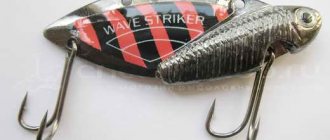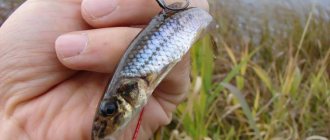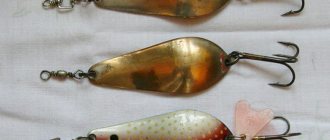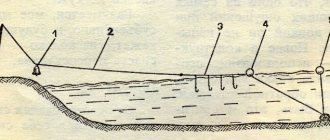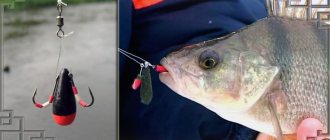What are the features of lure fishing for pike? Firstly, the choice of artificial bait material is important. Depending on the situation, copper or tin is used. Many people take lures with additional hooks. There is a lot of controversy about this. Some say that the action of the spinner is completely lost, while others insist that if the fish grabs the bait, it will no longer be able to escape.
The second point is that the spoon is good where there are a lot of these fish. But there are not many places where pike are freely found in abundance. Therefore, you will have to work hard before you can achieve serious success. You can't just catch a big pike. We'll have to catch the fish. Some even prefer to take a gaff with them. Be careful. A big fish will be strong enough to make you fall out of the boat. She, of course, is not a shark, but caution will not hurt. The pike makes a throw at the spinner. Moreover, from a great distance.
80% of fishermen believe that fishing is best in the fall. Especially when it comes to spinners. But her biggest meal is in the spring. Therefore, if you want to increase your chances, it is better to go fishing at this time. The second important point is peace and quiet. If the river is noisy, then don’t expect everything to work out. Therefore, choose a time and place when there is no one around except you whose actions could scare away the fish. When the fish starts to eat, it is best to take spoons and spinners. Many fishermen advise using spinners. To be sure, you can try all methods at once.
Read: Twitch wobblers. Selecting a rod for jerking
If you are looking for a bright and time-tested spoon for troubled water, you can buy the Eppinger Daredevil Spoon. Suitable for both standard casting and trolling. The second contender is Mepps H210. This is a very heavy turntable measuring 22 cm and weighing 75 g.
Advantages
The spinner has the following advantages:
- Durability. This type of bait is made of metal. It cannot be broken, much less a predator is able to bite through it.
- Huge assortment. It won’t be difficult to choose bait for any situation.
- Opportunity to fish at any time of the year.
- Sufficient heaviness. Thanks to this, the lure can be cast far from the shore. This is especially true in the autumn, when the pike
moves a considerable distance. There is no need to buy or rent a boat. - Relatively low cost. The price of spinners is cheaper than wobblers and similar baits.

Rice. 1. If the predator does not bite, then you can always change the spoon to a more catchy one, because There are no problems with the assortment.
Choosing a spinner for pike fishing
The most common lures for catching pike with a spinning rod are rotating (“spinners”) and oscillating (“oscillators”) spoons.
It makes sense to take a closer look at the advantages and conditions for using each of these groups of baits:
Oscillating spoons
The oldest type of bait used in spinning fishing. Despite the emergence of new and more modern options (wobblers, silicone baits, spinnerbaits), “shakers” have also not lost their relevance, and their presence in the arsenal of any fisherman will be the key to a successful bite. Depending on the reservoir, you can use this type of spoon with either a triple or double hook, or with an offset hook.
The advantages of “oscillators” include:
- Easy to use. For beginners, this factor is very significant. At first, you can be guided by a simple rule: give up and pull.
- Different fishing line reeling speeds and the use of different wiring techniques. This factor can be critical to successful fishing depending on the depth of the reservoir, the speed of the current and the activity of the fish.
- Long cast. It is important when fishing from the shore in large bodies of water.
- Relatively low cost.
The color of the “shaker” can be decisive. When fishing in cloudy water, it is better to have a brighter lure, while in clear weather in clear water it is recommended that the bait be darker in color.
Of course, the larger the spoon in size, the higher the probability of catching a trophy specimen, therefore, if the target is a large predator, then it is more advisable to use a spoon that is at least 9 cm in size and weighs from 24 grams. In addition, heavy “shakers” are almost indispensable for fishing in deep reservoirs with strong currents. For fishing on the track, it is also better to use an oscillating spoon of medium or large size.

Spinners
They are smaller in size compared to “oscillators”, but their play is more intense and noticeable due to the metal rotating petal.
Advantages of "turntables":
- Intensive game even at low speed.
- High “catchability”, since, thanks to the design features of the “spinner”, the fish “hears” this bait even at a considerable distance from it (up to 20 meters).
- Easy to learn for beginner fishermen. Beginners do not need any special skills when using this bait; it is enough to cast and carry out a slow, even retrieve.
It is most advisable to use a “spinner” when fishing in moderate and fast currents with a fishing depth of about 3–4 meters. Light and small spoons (No. 2, 3 according to the Mepps classification) of this type are quite suitable for fishing in quiet, deep places (pools, creeks). Slow wiring will work best here.
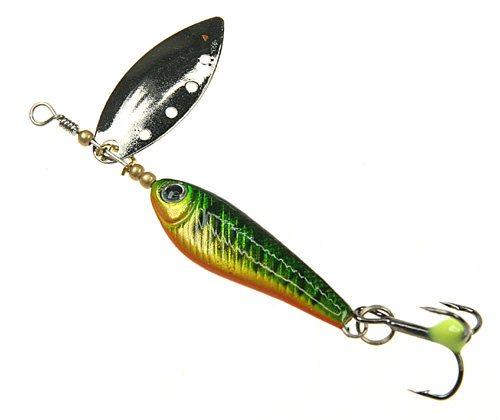
The most catchy varieties
Before deciding which bait to catch pike with, you need to understand the features of each type of spinner. There are quite a lot of them.
Spinner Kastmaster
It is made by cutting an iron rod at a certain angle. Many people believe that it is advisable to catch only asp with this type of spoon. However, this is not so; pike also happily go for such a bait.
The main advantage of the Kastmaster spinner is its fairly heavy weight. Thanks to this, it can be cast far from the shore without much effort.
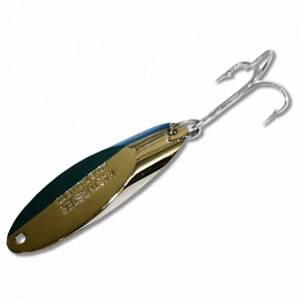
Rice. 2. Castmaster spinner.
Turntables
This bait consists of a base and one, two or even three petals. The first option is the most common. The petal rotates around an axis, creating vibration and sound waves. Fishing with spinners is very effective, so every fisherman should have such a spinner in his collection.
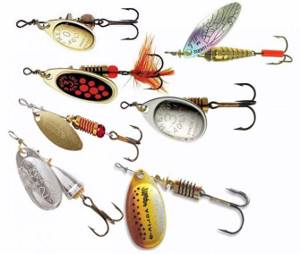
Rice. 3. Models of turntables.
Oscillators
This is a metal plate with a hook at the end. It comes in various shapes, colors, sizes. Each model has an individual playing style . Some move through the water smoothly, without sudden movements, while others twitch from side to side like frightened fry, while others dive down and rise back up like wounded fish.
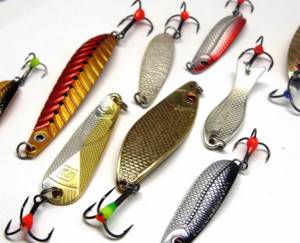
Rice. 4. What do oscillating spoons look like?
Noise
Lures of this type are similar to spoons or spinners, but they create strong noise and vibrations in the water thanks to special elements. The pike senses them even at a great distance and follows the impulses.
Bimetallic
These are the same vibrators, only they are made from two metals at once, for example, copper and an alloy. It is believed that this modification creates a weak electric current that attracts the predator and forces it to attack.
Unhooked
If you have to decide which bait to use to catch pike in the thickets, then a non-hooking bait would be the ideal option. This bait comes in various shapes and colors. A distinctive feature is that the tip of the hook is covered with a double on a magnet or antennae.

Rice. 5. Non-hooking spinners.
Features of baits
All pike lures are divided into two huge categories - rotating and oscillating. Both have their advantages and disadvantages, which determine the features of their application. However, both qualitatively complement each other, practically not limiting the fisherman’s capabilities.
When planning to go fishing for pike, a spinner should imagine what difficulties he will have to face. The following factors influence the choice of bait:
- where is the fishing done, from the shore or from a boat;
- at what time of year fishing occurs: spring, summer, autumn or winter;
- on which body of water the fisherman is hunting, on a river, reservoir, toad grass or lake.
It is important not only to choose the bait, but also to properly lure it to ensure the most attractive game. After all, any catchy model in inept hands turns into a banal piece of hardware that a predator will never pay attention to.
Turntables
Spinning spoons are more popular than oscillating ones. They are especially held in high esteem among beginners because they do not require fancy presentation techniques, are intuitive and allow you to catch pike in any conditions. These baits should definitely be in the ammunition kit of every spinning player.

The spinner is an effective lure for pike.
The pinwheels show the best results in the warm season, when the toothy beast is active. The predator begins to consistently respond to these baits in May. A good bite lasts until the end of September. Then the pike’s interest in spinning lures fades away.
The main places where rotating lures for pike are used are:
- oxbow lakes, branches, channels, backwaters and other branches from the main river bed with the presence of aquatic vegetation;
- reaches and branches of upper reservoirs;
- coastal strip of algae;
- shallow-water extensive locations with bottom vegetation;
- coastal edges and dumps.
Rotating spoons can be cast in any horizon, but it is best to place the bait in the water column or closer to the bottom. This way it is possible to catch the zone with the highest quality, prompting the spotted beast to lunge and grab a confident grip.
Advice! In currents, use spinners with narrow petals, in still water - with round ones.
The optimal spinner movement is uniform. The feed speed is adjusted to the mood of the pike. As a rule, the bait is presented on the verge of the petal failing, but there are situations when the spinner should be carried out at increased speeds, maximally imitating a running away frightened fry.
How to make your own lure for pike (homemade)
The most popular spinners for pike fishing are products from the French company Mepps. Over the decades of existence, these baits have earned recognition around the world, thanks to the highest quality of workmanship and amazing catchability.
In addition to Mepps spinners, domestic spinning anglers prefer baits from the following manufacturers:
- Myran;
- DAM;
- Blue Fox;
- Smith;
- Spinnex;
- Daiwa and others.
Some spinners make spinners with their own hands. With some experience this is not difficult. The main task is to get the necessary materials and tools for their manufacture and “get your hands on” so that the baits work stably, not being inferior to factory products.
For fishing on the riverbed, fishing holes, pools and other deep areas, especially fishing from the shore, front-loaded spinners, which are often called jigs, can be used. The most famous representative of this type of bait are the Master spinners, which have earned high authority among domestic jig lovers.

Tandem is an effective lure for pike.
A very interesting option, especially when hunting for large pike, are tandem spinners. These are baits that have two or three petals. Such a spoon creates strong vibrations, simulating large prey. As a rule, such noisy objects weed out outright trifles, but attract seasoned spotted predators.
Another good tandem is a spinner with a large petal, which has a rubber bait, a silicone skirt or a volumetric streamer on the hook. Such spoons are not necessary in a spinning player’s arsenal, but as an alternative to standard models they will not hurt, especially on pressed-in reservoirs.
Oscillators
Oscillating spoons were used for pike fishing by our great-grandfathers, for whom fishing was not just a pleasant pastime. The effectiveness of the vibrator has been proven for a long time and does not need confirmation. The main advantages of these baits are:
- universalism;
- catchability;
- Can be used all year round;
- relative ease of learning;
- low requirements for the sensitivity of the gear.
Oscillating spoons begin to be used as soon as the ice melts. In cold water in early spring, heavy models work, allowing you to fish deep areas. In the second half of spring, after pike spawn, on the contrary, light, wide-bodied baits designed for shallow depths are used.
Advice! Heavy oscillators qualitatively complement silicone when fishing with a spinning rod in winter, especially in February.
During the summer, light models are used, since the bulk of the predator “grazes” in shallow water near aquatic vegetation. In difficult places, you should use non-snagging spoons, the hooks of which are protected from snagging, which allows you to fish with them where ordinary baits cannot be reached.
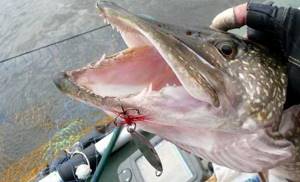
Pike really respect oscillating spoons.
In August, the pike gradually moves to deeper areas, and in the fall it completely slides down to the riverbed, holes, and goes to reaches and pools. Now she greedily takes narrow-bodied heavy spoons, which can be slowly held at the very bottom.
Fishing with jigs shows good results. The most famous model from this category of spinners is Kastmaster. Flashing this bait allows you to catch pike everywhere. They fish with it in all horizons, on any current - in general, everywhere where the spotted beast is found.
The placement of an oscillating spoon depends on the fishing conditions, the mood of the predator, the fishing season and other minor factors, such as wind strength, atmospheric pressure, the presence of aquatic vegetation, current, depth, the nature of the bottom, etc. The main animation techniques are:
- uniform;
- stepped;
- wavy;
- jerk.
The most universal is uniform feeding. As a rule, the bait is presented slowly at the bottom, imitating a wounded fry. If the pike is active and stays in the upper horizons, then the lure is cast at medium or high speed, imitating the behavior of a frightened fish.
Wave-like wiring is used when fishing along a strip of coastal algae or when fishing across areas in locations with medium depths and uneven bottom topography. And also this animation technique allows you to fish in areas with abundant creeping aquatic vegetation.
Important! Pike likes to stand among bottom vegetation, attacking objects floating above its head.
The jig “step” is good for fishing riverbed areas. These are dumps, deep rifts, long holes and ditches, whirlpools and inflows. The rules for feeding the spinner are similar to wiring silicone baits. The difference is a longer pause due to the fact that the spinner is gliding as it sinks to the bottom.
Jerk elements are added to the retrieve when the pike refuses to respond to a uniform, wave-like or stepped feed. By adding various jerks and twitches to the animation, it is possible to imitate the convulsive movements of a fry, which will not leave a sluggish and apathetic predator indifferent.
When is the best time to catch
This bait is universal, it can be used at any time of the year, even in winter. However, the best bite is observed in the fall. The fish is preparing for winter and actively hunting to gain weight.
The best time to go fishing is early in the morning or at dusk. The predator bites well at a depth of 1-2 m . The catch is especially rich before freeze-up; it is at this time that the so-called “zhor” occurs.
In the last days of autumn and winter, pike activity becomes worse. It reacts poorly to bait, especially before the first snow falls.
In the spring, the predator begins to eat again. When the ice melts, it is very easy to catch large specimens with spoons. The best bite is observed in reservoirs with clear water and thickets, where many fry live.
In the summer, it is better to engage in deep fishing. The predator spends a lot of time in cool holes and shady places. He goes hunting before the first rays of sunshine, i.e. from approximately 4 to 8 am.
How to choose the right tackle to catch?
The concept of “spinner” includes a wide range of baits with very different properties, so coming to the store and simply saying: “Give me a spinner for pike” will be completely wrong. In order to choose the right lure for pike fishing, you should first of all clearly understand the fishing conditions, namely:

- Depth at the fishing spot. The deeper, the more the spoon should weigh.
- Presence or absence of current. The stronger the current, the more weight the bait should have and the more streamlined it should have.
- Required casting distance. If there is a need to deliver bait over a considerable distance, it must have good aerodynamics, which means its compactness and high specific weight.
- The presence of obstacles in the fishing area, such as different types of vegetation, snags, stones, shell rock, etc. For fishing in such conditions, it is necessary to use spinners that have hook tip protection.
- Water transparency. Based on the level of water transparency, the color of the spoon is selected, as well as its “noisiness”, i.e. the ability to create acoustic vibrations, since in turbid water the pike is guided not so much by vision as by the lateral line.
Thus, when choosing a lure for pike, you should pay attention to the following properties:
- size and weight;
- form;
- design;
- color.
Other important characteristics of a spoon are the quality of the hooks with which it is equipped and the metal (or other material) from which it is made.
Expert opinion
Knipovich Nikolai Mikhailovich
Zoologist, hydrobiologist. I am interested in fishing at a professional level.
As you know, most lures are made of ferrous and non-ferrous metals, although some lures are made from plastics. An exact copy of a spinner made of brass or copper, embodied in ferrous metal, may have significantly lower catchability.
If the lure is painted, the ability of the paint coating to withstand pike teeth and environmental factors must also be taken into account.
How to choose a spinner depending on the time of year
In spring, it is advisable to choose rotating spoons. The bite largely depends not only on the time of year, but also on the place and method of fishing. Therefore, before you find the best option, you will have to try baits of various shapes, colors, and sizes.
In summer, pike are in a passive state, so small baits (3-10 cm) in neutral colors are suitable for fishing.
In autumn, the predator prepares for the winter, so it rarely hunts for small things. It is recommended to choose large (10-12 cm) and heavy spinner spoons.
In winter, pike will not take large bait. You need to choose small (up to 8 cm) and light (5-30 g).
The coloring should not be too bright so as not to scare away, but you should not choose very dull ones, which will not attract a predator.
Choosing the time and place of fishing
Mid-autumn and a few weeks after spawning
are justifiably considered the best time for fishing for pike using a spoon. True, fishing from the shore in large bodies of water during this period will be quite difficult, since aquatic vegetation begins to die off, and the predator moves into deeper places. To catch pike from the shore, fishermen prefer to choose the warm season, since it is in the summer that it is easiest to catch it without a boat.
Pike hunt from ambush, and this fact has been known to all fishermen for many years. She waits for prey in cover, and as soon as it appears in sight, she attacks her with a short but sharp jerk. The logical conclusion follows from this that the best places for fishing can be areas of the reservoir where there is somewhere for the predator to hide.

The chances of catching pike in aquatic vegetation near the shore or snags are approximately the same. Frequent sites for the toothed fish are islands of aquatic plants and corridors in the reeds. A strong current does not attract pike, but rather repels it.
What color should the bait be for a predator to peck at it?
Recommendations for choosing bait color:
- dawn and dusk - silver shades;
- sunny days - dark and neutral tones;
- rainy weather - matte gold-silver;
- water with turbidity - bright, acidic shades;
- Pinwheels can have different petal colors; large specimens bite better on a matte silver color.
Rice. 6. When fishing with oscillating bait, color does not play an important role. You can take baits even in unremarkable colors, for example, white.
Oscillating lures for pike
Nobody knows for sure when spoons, lures for catching pike with a spinning rod, appeared. They were probably invented by primitive people along with a primitive hook for catching fish. Since then, the oscillating spoon has brought a lot of benefits and has earned honor and respect, so it would be unfair to consign it to oblivion.
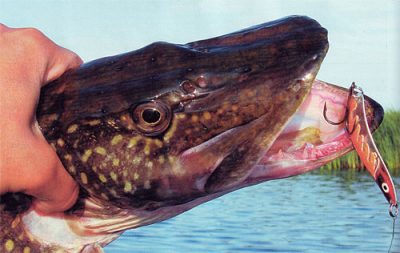
Of course, today, due to progress in the fishing industry, it can no longer claim to be universal, but this is not a reason to abandon it forever. On the contrary, it must be in the spinning player’s arsenal. Why? There are days when a very active pike, for some reason known to itself, refuses to take expensive wobblers and edible rubber. But he is interested in hardware. Even an inconspicuous-looking spoon outperforms modern sophisticated baits, provoking predators one after another.
The spinner is suitable for those who have just begun to master spinning and are not yet familiar with all the nuances of this type of fishing. It is very easy to use. Throw it in - pull it out, what's so difficult about it? Later you can improvise: change the pace of the retrieve, change the pattern, try baits of different weights.
How to fix
Before catching pike, you need to securely attach the spoon to the fishing line. To do this, you need to make a leash between it and the nozzle, which the predator cannot bite. There are two simple ways to secure a lure.
The first is called “loop to loop”. It is used by most fishermen. The attachment is very simple, so the bait can be quickly changed at any time:
- Make a loop at the end of the fishing line.
- Guide it through the winding ring on the attachment.
- Pull the loop through the plate.
- Tighten the knot.
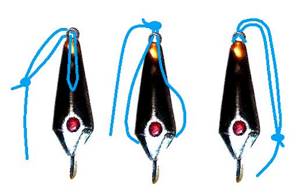
Rice. 7. Loop-to-loop tying technique.
Second mounting method:
- Place the free end of the fishing line in the opposite direction.
- Wind around the loop 2-5 times.
- Place the remaining part of the fishing line in the same loop.
- Tighten the knot.
Rice. 8. Visual diagram of the second fastening method.
Rotating spinners
Domestic spinners "Adams" with front loading
A good option for mastering the basics of spinning fishing is a spinner. Fishing with a spinner is quite simple, and even a beginner can easily feel the work of the spinner. With normal, uniform fishing, the spinner produces vibrations that the fish picks up from afar. Depending on the size of the spinner and the depth of the reservoir, the pike “hears” the bait at a distance of 10-20 m.
Among the disadvantages of rotating spinners, it is worth mentioning:
- poor flight characteristics;
- frequent overlaps of the fishing line;
- the use of one or two types of wiring;
- problems with bottom fishing in the current.
When choosing a turntable, the most important thing you need to pay attention to is how well the game is played by this model. Branded Mepps spinners have a stable game, the spinner “starts up” at the slightest twitch or movement of the spinner. At the same time, Chinese fakes from a similar company look almost the same, but the game is disgusting (in order for the bait to start rotating, sometimes it is necessary to make a meter-long jerk with the tip of the rod). It is impossible to make a slow retrieve with a low-quality spinner. Conclusion: don’t skimp on good lures, but at least try the branded version and see the difference.
When pike are active, there are more bites on the spinner than on the spoon. But the size of the fish caught will be slightly smaller.
The main criterion for a high-quality spinner is the easy rotation of the blade with the slowest retrieve. This bait will interest the most passive pike.
The best turntables are produced by such companies as:
- Mepps;
- Blue Fox;
- Daiwa;
- Myran;
- Cormoran;
- Abu Garcia.
The most optimal price-quality ratio is observed in Mepps spinners. For targeted pike fishing, spinners no smaller than No. 3 are required. For fishing near the bottom, it is preferable to use “long” and “long heavy” models. It is better to fish shallow water with spoons such as “Comet” and “Aglia”.
In summer, pike can ignore large spoons. Then you need to switch to turntables No. 1-2 with a “willow leaf” petal.
Mepps Long spinnerbaits in the shape of a willow leaf. If the pike is too passive, reduce the size of the bait to standard No. 2
To reach pike on deep edges and holes, you need to use front-loaded spinners:
- Lusox by Mepps;
- "Adams" and "Master" of domestic production.
You can perform a jig spinner in the following ways:
- uniform wiring;
- wave animation;
- step at the bottom.
On the basis of a rotating spoon, many variations are produced with several petals, propellers, and silicone additions.
We choose the best wobblers for pike for spinning fishing - shapes, depth and other important characteristics, top baits.
Pike on a spinning rod - the most detailed guide for beginner anglers.
Winter lures for pike - which lures to choose and where to look for the toothy hunter.
Wiring technique
The success of fishing depends not only on the correct choice of spoons, but also on the fishing technique used. It should imitate the movements of weakened or sick fish, which are the prey of pike in the natural environment. It’s not difficult to learn, you just need to practice a few times to find the best option:
- in the form of wave movement - the bait is lowered and raised;
- twitching - the movement is smooth, only slight twitching of the spinning rod is made for better play of the bait;
- stepped - this technique is used in lakes and rivers in which there are holes at the bottom; the spoon first lies down, and then rises with a slight jerk and continues the retrieve.
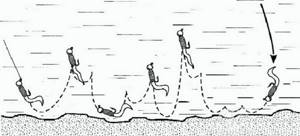
Rice. 9. Step wiring diagram.
How to catch pike, with what bait, is up to the fisherman himself to decide. However, if you follow all the recommendations given above, you will be able to achieve an excellent catch. After all, all the advice was compiled by experienced fishermen through trial and error.
How to fish with a lure
Of course, correctly selected gear and bait are of great importance for successful fishing, but the tactics and technical side of fishing are no less important.
Casting
Truly, fishing begins with him. If the reservoir is quiet but wide enough, then it is better to cast with a fan, with each subsequent one a little further than the previous one until the optimal option is determined. On a river with a medium or fast current, you need to cast the bait diagonally. If the bottom is uneven, replete with driftwood or other possible obstacles, then you should not wait for the spoon to sink to the bottom, because in this case the risk of catching a snag or stone becomes much higher.
Wiring
The most effective retrieve for catching pike with a spinner is slow and steady. At the same time, this is far from the only method and, depending on the conditions and characteristics of the reservoir, the wiring should be combined.
Other wiring methods:
- Wavy. Most effective when fishing for active pike. The wiring then slows down, then speeds up again, while sinking lower to the bottom or rising to the surface. In this case, it is better to keep the reeling speed at an average level, and adjust the reeling by raising or lowering the rod. This method works best in the warm season.
- Stepped. Suitable for uneven bottoms with lots of holes or protrusions. When passing a spoon through a hole, it makes sense to delay the wiring, wait until the bait drops slightly to the bottom, and then continue the wiring with a slight jerk.
- Twitching. With this method, the wiring is uniform, but it is necessary to make slight twitches with the rod in order to diversify the play of the lure.
Sweeping
It is carried out sharply and quickly. When biting, you must immediately move the rod to an angle of 40-60 degrees - this will help to more effectively absorb fish strikes. You need to make sure that the pike does not take the bait into the thick grass, as there is a high probability of getting caught there.
How to make a spinner spoon
This type of hunting projectile can be made independently at home with minimal cost and with exclusive performance parameters. You can make oscillating spoons with your own hands in two main ways, by adapting a spoon scoop for the bait or by pouring the shape needed for the bait from fusible metal.
The first method involves processing it to match the shape of a spoon. To do this, the handle of the cutlery is cut off, and the scoop itself is modified by drilling holes in opposite parts of the oblong shape. One hole will serve for mounting a tee, and the second for attaching the homemade product through a swivel to the main cord of the tackle. We described in more detail how to make a spinner from a spoon in a separate article.
Important! The elements are fastened through winding rings.
Making spinners from castings is a more complex process, requiring the fisherman to make a casting mold from plaster. Initially, the desired matrix is prepared from plasticine and filled with gypsum mixture. Subsequently, the plaster mold is filled with molten lead or tin. Next, the workpiece is processed with a file and, by analogy with a spoon, fastening elements are arranged. The manner of guiding the oscillating spoon will depend on the configuration and depth of the concavity of the workpiece body. The required mass is added to the product by soldering or peening of additional material.
Important! After grinding the edges and polishing the side surfaces of the product, it is subjected to final painting, which can be done with metal markers, giving the spinner a fighting and promising color.

